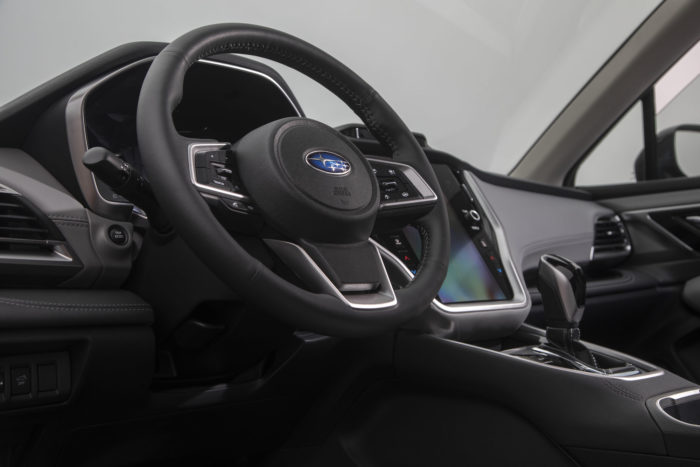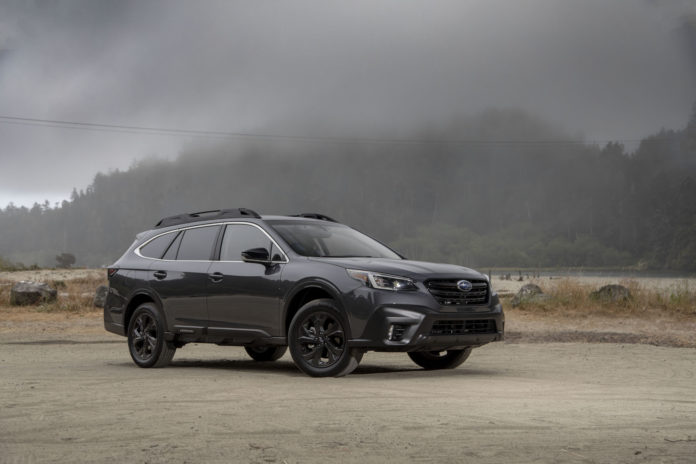The latest Outback is the sixth generation of Subaru’s raised-and-cladded wagon. Competition for the crossover pioneer is stronger than ever, not least from within Subaru. This is the first Outback to be launched since the arrival of the larger, three-row Ascent and an all-new Forester that, although smaller overall, near-matches the Outback for cargo space.
These days Subaru calls the Outback an SUV, presumably – and sadly – because no one’s buying wagons. The all-new 2020 edition joins its stablemates on Subaru’s Global Platform and gets revised looks and contemporary passive safety, driver assistance and infotainment kit. We spent a week with an Outback Premier, which is roughly equivalent to the US Touring spec.
Related: all our wagon reviews here.
2020 Subaru Outback Price
Across the US, the five-model Outback range starts at US$26,645 and tops out with the Touring XT at US$39,695. Once again, the top three XT grades get the turbo motor.
In both Canada and the US there are seven models in the 2020 Outback lineup. In Canada it starts with the Convenience at C$30,695 and rises to the Premier XT at C$43,795.
Our Premier test car sits right in the middle with a base price of C$40,995, making it the most expensive of the four trim levels with the 2.5-litre, 182 HP, naturally aspirated engine. The three XT derivatives above it have the 2.4-litre, 260 HP turbo unit that’s also seen in the Ascent.
More on pricing, check out:
Exterior styling
First up, the looks. According to Subaru, “Following a ‘Dynamic x Solid’ philosophy, the all-new Outback is anchored to an ‘Active x Tough’ concept”. We’ll be honest, we’re not sure what that means… The car does look rugged though, complete with hiking-boot-inspired cladding shapes. It also looks like an Outback – and to our eyes, a more stylish one than the outgoing model.
Related: Subaru’s redesigned 2020 Outback arrives this fall with major changes

However, we think there’s still something odd about the stance. Subaru may call it an SUV but this is a crossover wagon body style, with all the good stuff that entails (see also our recent drive of the Volvo V60 CrossCountry): a long, low shape and decent luggage capacity.
Unfortunately, as with its predecessor (the 2018 Outback Premier reviewed here), what Subaru calls the “dynamic silhouette” has then been jacked skywards to provide 8.7in of ground clearance to enhance the car’s serious off-road credentials. Most of its SUV rivals ride lower. Even a Jeep Grand Cherokee in non-Trailhawk spec has marginally less ground clearance than the Outback.
We’d love to have seen the Outback re-embracing its crossover wagon heritage with an inch less of ground clearance, which would not only look great but benefit on-road handling and safety by lowering the centre of gravity – and reduce drag for better fuel economy, too.
The test car came finished in a beautiful shade of Abyss Blue Pearl. Refreshingly, there’s no price premium for fancy exterior colours. The chrome door handles and satin chrome mirrors are exclusive to the Premier trim.
2020 Subaru Outback Interior and Equipment
There’s a welcome simplicity to specifying your Outback: simply pick the grade that has the equipment you want. There are no hidden charges lurking in must-have but notionally optional equipment packages. The only items you might want to pay more for are accessories such as bike racks, roof boxes or interior or exterior protection packages.

The Premier trim level has a high level of standard equipment. Key additions over the lower grades are the brown Nappa leather and ventilated front seats. For the US Touring trim, you can add power moonroof and heated steering wheel to that list of exclusives, but they’re available on other trims in Canada.
We liked the comfort of the front seats and the kids gave the thumbs-up to those in the rear – and appreciated the rear-seat heaters in a test week when the temperature hovered around -25°C (-13°F).
The front-seat heaters are one of many functions activated by the 11.6in, Subaru Starlink portrait touchscreen. Basic HVAC functions still get push buttons, but not the seat warmers. Admittedly that’s not an issue for drivers in warmer climates, but in the Canadian winter it’s a pain to have to go through a two-step process to activate the heater via the screen. Those who like to keep an eye on the tech might want to know that Starlink runs on open-source, automotive-grade Linux.
The Harman Kardon 12-speaker audio system is one of the best we’ve tried recently…
The Harman Kardon 12-speaker audio system is one of the best we’ve tried recently. We’re told that it features a new GreenEdge technology that provides a more powerful sound while consuming less energy. On the Premier there’s even a CD player for anyone who still prefer albums to playlists.
2020 Subaru Outback Cargo Space & Capacity
The Outback swallows 920L (32.5 cu.ft) of cargo with the seats up, rising to 2,144L (75.7 cu.ft) with them flat. If you have an older Outback, note that it may not be straightforward to compare figures with previous models as the measuring standard recently changed.
From what we can determine, the space behind the second row – which is how most families will use the luggage area – is now wider than before, but slightly smaller overall. As before, you’ll still likely need a roof box for vacations, ski trips and the like.

Engine and transmission
The 2.5-litre four-cylinder is 90% new, according to Subaru, and offers a modest horsepower gain over the old unit – up from 175 to 182 HP. It pulls well enough and we liked its smoothness, but the Boxer motor’s characterful engine note is well hidden. That’s a pity, because this type of engine is synonymous with Subaru and distinguishes it from rivals – as the company itself likes to point out.
Related Read: Closer Look at the 2020 Outback’s Towing Capacity
When you do hear the revs, they’re often not where you expect them to be, thanks to the way the CVT transmission works. We weren’t fans of the Lineartronic CVT in the Ascent and we didn’t warm to it here, either. We’d still rather see the engine paired with a conventional automatic – or at least a CVT that simulates one, Hyundai-Kia IVT-style. We might be wrong, but we feel that in North America, a majority of drivers would prioritize the feel of an auto over any fuel economy benefit that the CVT can offer.
Speaking of which, the 2.5/CVT combo returned 11.2L/100km (21mpg) on mixed roads in deep-freeze conditions. Understandably, that’s well above the official combined consumption figure of 8.3L/100km (28mpg).
Driving impressions – on-road, off-road and towing
The 2020 Outback has gained better soundproofing materials and thicker glass. We were impressed by the cabin’s quietness in the cruise, backed up by well-judged ride quality both at speed and around town. In an age of oversize wheels, the 18in alloys on this top-spec Outback are a welcome, sensible choice.
The only caveat to the ride comfort piece is that we were running Toyo Observe GSi-5 winter tires rather than the regular all-seasons.
During evaluation for the 2020 AJAC Canadian Car of the Year Awards, in which the Outback won Best Mid-Size Utility Vehicle in Canada for 2020, we drove a turbocharged Outback on an autotest course. The car handled well, despite its size and ride height. We weren’t able to fully explore the handling on-road during our test week due to the harsh weather, but we would have liked a little more weight to the steering.
We were impressed by the cabin’s quietness in the cruise, backed up by well-judged ride quality both at speed and around town.
We’re happy to report that there’s no meaningless ‘Sport’ mode to select on this family hauler. Instead, the switchable X-Mode provides another level of off-road capability by using the transmission, traction control system and brakes differently when climbing or descending, or on slippery surfaces.
Again, as part of the Car of the Year evaluation, we were able to try the car back-to-back against some of its key competitors on a demanding off-road route. It performed superbly.
The Outback Premier will tow up to 1,225kg (2,700 lb). The figure rises to 1,558kg (3,435 lb) for Outback XTs with the turbo motor.
Driver-assistance tech
Subaru’s EyeSight suite of driver assistance technologies, which now includes adaptive cruise control with lane centring, is standard on all Outbacks. In addition, the Premier gets the new DriverFocus distraction mitigation system. Combined with improvements in passive safety, the tech contributes to the Outback getting an IIHS Top Safety Pick safety rating.
There are plenty of good intentions and useful functions here, such as the very effective rear cross-traffic alert and the way the backup camera gets a clean when you wash the rear window.
Unfortunately, some of the EyeSight technologies are frustrating to use. The red, green and yellow lights of the EyeSight Assist Monitor – which pop into the driver’s field of view to indicate vehicle movements ahead on the highway – are distracting, and the accompanying beeps that signal changes ahead, irritating.
Meanwhile the DriverFocus system could use a recalibration, in our view. Several times in the course of the week, it told me to keep my eyes on the road when I was looking in the rear-view mirror, rubbing my eye or glancing down at the Starlink screen to switch on the heated seat. Buyers want huge, phone-style screens, but until the driving process becomes fully automated, they will remain an equally huge distraction to the human driver – with a knock-on safety impact. Auto makers have yet to find a way to navigate these conflicting priorities.
More generally, our fear is that the intrusiveness of some driver-assistance systems will cause drivers to switch them off (easily achieved via a Starlink settings menu) – at which point, there is no safety benefit. As vehicles become able to provide increasing levels of driver assistance and move towards increasing levels of automation, it’s imperative that the calibration of these technologies is correct, so that users readily see the benefits of new developments and learn to place their trust in them.
Takeaway: What’s our take on the new 2020 Outback?
My everyday car is a 2003 Subaru Outback. Like the 2020 model, it has a 2.5-litre Boxer engine, roof bars, raised ride height and body cladding. But it’s smaller, especially in the interior accommodation, has far fewer creature comforts and safety features and, after more than 240,000km, is showing its age.
You Might Like: GC8 Great – An Insane Street-Legal 1998 Subaru Impreza 2.5 RS Coupe
Comparing old cars to new ones is largely pointless but my old Subie does have a more characterful engine and more communicative steering than its 2020 descendent. It also has an automatic transmission that just feels right for this type of car. In short, it’s more engaging to drive. It also consistently returns its official fuel consumption figure, something that’s rare in modern cars.
The 2020 Outback is a product of the current vehicle market, majoring on connectivity, safety and fuel economy numbers. Subaru calls it an SUV because that too is what the market wants, but we’re nonetheless grateful that it’s one of the few companies still making crossover wagons. Objectively it improves upon the old model in many respects, but we worry that Subaru’s outsider kudos could be lost forever if driver appeal and user-friendliness continue to play second fiddle to bland powertrains and well-intentioned but frustrating safety tech.
Learn more here
2020 Subaru Outback Canada | 2020 Subaru Outback USA
Pros: We Like It
– Wagon-like style
– Quiet, comfortable ride
– Off-road credentials
Cons: Needs Work
– Counterproductive driver-assistance tech
– Characterless powertrain
– Excessive ride height in normal use
Photos of the 2020 Outback:
- 820
- 820shares
























